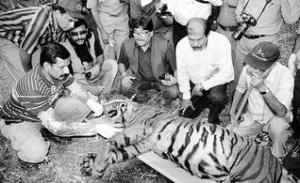Post on Forum |
My Forum Contribution |
Forum Home
Posted by
Soumya Banerjee
on
August 16, 2015
Recently, several articles were brought out highlighting the loss of 41 tigers from India’s forests over the first 7 months of 2015. A variety of causes were responsible for these deaths, ranging from infighting, to poisoning and killing for skin and bones
by professional poachers.
http://economictimes.indiatimes.com/news/environment/flora-fauna/india-loses-41-tigers-in-7-months/articleshow/48446348.cms
However, what does this say about the efficacy of India’s tiger conservation programme? Wildlife scientists have always held that tiger populations experience high turnovers-they are prolific breeders, but also die young. This may be borne out by the reasonably
high number of annual tiger deaths recorded over the past few years-61(2014), 76(2013), 89(2012), 56(2011) and 53(2010). Intensive monitoring of tiger populations actually tells us that the recorded death figures are actually a fraction of the total number
of deaths. If populations are adequately from adverse factors such as habitat loss, poaching and conflict, then the naturally high rate of reproduction will ensure that tiger populations continue to thrive.
Which is what brings us to the next question- how indicative are these deaths of the effects human-induced adversities on tiger populations ? The likely answer is- that they present a highly incomplete picture. For instance, only 3 seizures of tiger parts
have been made from poachers this year; the figure was 12 in 2014. However, independent investigations indicate that only a small percentage of seizures come to light.
 A
tiger skin being seized from poachers.
A
tiger skin being seized from poachers.
Credit : Telegraph India
. Official investigations into such deaths are also marked by a lack of transparency. Officials are usually very keen to make it look like as if every instance of tiger death is a result of natural causes, which often causes many instances of tiger poisoning
to be swept under the carpet. Many carcasses are recovered in an advanced state of decomposition; which, coupled with a shortage of adequately trained vets, means that the actual causes of death are determined in only a very small number of cases. Details
of investigations into tiger deaths are still awaited in as many as 33 of the aforementioned 41 cases.
 An
investigation into a tiger death in progress in Mudumalai Tiger Reserve.
An
investigation into a tiger death in progress in Mudumalai Tiger Reserve.
Credit : The Hindu
Wild tigers continue to be threatened by innumerable factors ; but tiger death statistics alone cant quantify these threats.
Share this post:
